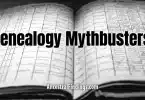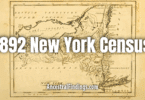Census research is one of the first things most people learn how to do outside of talking to family members when they begin their genealogy research. And, no matter how long you are a genealogist, you will always come back to the census. It is excellent for confirming findings from other record sources, begin research on new lines in your family, and to look for missing ancestors (or those you didn’t examine in-depth the first time you saw their census entry). You can even look at a census entry for someone many different times over many years, and even decades, and get something new out of the information on the entry every time. The census is more than just gathering names and ages off of a page. You can get some really important, otherwise unavailable information on your ancestors from it.
Here are three ways to make the most out of your census research.
1. Look at Other Things the Census Says
You may be looking at the census just to get the names, ages, and birthplaces of your ancestors, and this is good. You should do this, as it is a basic research task in genealogy. Looking up these things on the census records can tell you a lot about your ancestors you never knew, such as children, parents, and other relatives who are living with them who you never knew existed. You can also get important information on their origins and the origins of their parents. There is more to most census records than just this basic information, however,
Some census records, like 1850 through 1870 censuses, only give you the basic information. Others, however, have a treasure trove of other information you can use. Depending on the census, you may find things of important genealogical significance, such as:
- Whether or not an ancestor served in the Revolution or Civil War
- If they were a slave owner (and how many slaves they owned, sometimes even by gender and age range)
- Their level of schooling
- Their occupation
- The number of children a woman has given birth to and how many were still living
- The year of marriage
- The number of marriages a person has had
- The month and year of birth, the year they immigrated to the United States
- Whether they were a naturalized citizen or not
- Their address
- Their native language
- Whether they could speak English
- Whether they could read or write
- Whether they had any disability
- Whether they rented or owned their home
- And more
These are all things you will want to put in your family history research.
2. Use Unique Ways to Look Up Names
Census takers didn’t always spell names correctly. If it was an unusual name or a foreign one spoken by foreign people, the census taker may have spelled the name phonetically, or misheard it and spelled it completely differently from anything it was supposed to be. You may think your ancestor is not in the census, but this is because you haven’t checked using all the search methods that can lead you to them.
This method works best on online census records that are searchable with an interactive index, such as on Ancestry.com and FamilySearch.org. Try the following search methods to discover your ancestor:
- Search by the first name only, with an age range, gender, and location
- Search by the last name only, with an age range, gender, and location
- Search only by age range, gender, and location, with no name
- Search by age range, gender, location, and place of birth, with no name
Using any of these methods may lead you to the ancestor you seek. You’ll know the person when you see them, even if their name is spelled completely incorrectly. They’ll be even more obvious if they are living with recognizable family members you already know. Remember, not everyone made it into every census, so your ancestor may legitimately not be there. But using these techniques will weed them out if they were recorded.
3. Use Earlier Census Records to Your Advantage
The 1790 through 1840 census records only list the name of the head of the household, but that doesn’t mean you can’t glean more information from them than this. They also include lists of how many people are living in the household, and most of them categorize these people into gender and age groups within those genders. Really early ones may even include listings of who is free and who is the slave in a household, and categorize the slaves into genders and age groups, too.
You can use this to your advantage by comparing the names and ages of people in that household on later census records where they are all listed, to get an idea of who was in the household in earlier census records. You can also discover new ancestors by looking up the head of household in old newspaper records and discovering mentions of his or her family. Obituaries, wedding announcements, and birth announcements may be in old newspaper records and give the names, and even ages of family members who were never recorded in a census by name. You can use this information to fill in the names of the people in a household in earlier census records. Wills and probate records are another excellent source of family names that you can use to fill in an earlier census with names. It takes a little bit of detective work but can give you a fuller picture of your family history, so it’s well worth doing.






